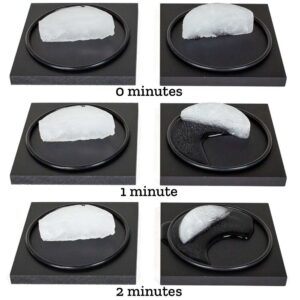 by: Janice VanCleave
by: Janice VanCleave
Identify the Physical Properties of Mystery Artifacts
The mystery artifacts used for this investigation are special and can be purchased at Educational Innovations. The artifacts are called “Ice Melting Blocks,” but this name gives too much information. Prior to the investigation, I suggest that you introduce them as artifacts, objects that have been intentionally made or produced for a certain purpose.
Objective:
To investigate mystery artifacts and determine their possible purposes as well as the real or imaginary culture that might have made them. Set the stage by placing the mystery artifacts on a table and covering them with a cloth. If possible, screen off the investigating area so that only the “student science explorers” can view the blocks.
With students in groups, select one “Student Science Explorer” from each group. Hand each explorer a pencil and clip board with paper. Inform the class that group explorers will use only their senses to investigate mystery artifacts. Information collected by each explorer will be shared with their group. Using this information,the group will describe possible uses for the artifacts as well as the culture that might have made the materials.
Instruct the explorers that they are not to communicate with each other. But, as a group they are to investigate the mystery materials. Give no clues to these explorers about the physical properties they should observe. Using a time, limit the observation time of the explorers. Try two to three minutes. Extend the time if needed.
Remove the cloth covering the blocks and start the timer. While the science explorers are making their observations, hand out instruction sheets to the groups. The instructions are simple, using the information collected by their science explorer the group is to compare the following physical properties of the artifacts. No clues about how to record the information. No clues as to how to estimate the volume. Resources should be available if groups need them to review some of the properties.
- Color
- Volume- Estimate in cm 3
- Mass (inertia)–comparative measurement/Relative Density
- Shape (geometric name)
- Temperature
- Heat Conduction or Insulation Properties
Each group can decide if they need to send a second explorer to make an observation. It is up to you as to how many explorers from a group may be used.
Class Discussion Time:
This will be a time for groups to share their findings. Following are questions and answers that provide information about the mystery blocks. Allow each group to provide answers. While all answers from groups may not be correct, all answers are to be considered as possibly being correct. My comment to answers that I know are incorrect might be, “That is an interesting possibility.” Sometimes, with a little twist, a little tug, and lots of reforming of an incorrect answer via making suggestions and letting the group think about it, a wrong answer might be revised and voila’ “they” have discovered a correct answer.
Did you notice that I said “They” (the group) does the discovering? Know that a teacher’s job is to push, tug, and prod, via inquiry questions so that when investigating, students make new discoveries. In other words, without giving the answers, give more and more clues until the light turns on and the students have put together all the pieces. I’ve had students suddenly say, “Don’t tell me, I got it? It is much like a quiz show you see on TV, but no one is counting how many “clue-notes” must be heard before the student can “Name that Tune.”
Also notice that I said, ” …discover ‘a’ correct answer.” There is rarely one correct answer and there is always more than one way to find answers. While it is important to provide safe procedures for science investigations, within boundaries, allow students to design their own investigations as often as possible.
1. What is the color of the artifacts?
The blocks are black on all sides.
2. How was the volume determined?
The explorers could have used their hands to estimate the length, width, and height of the blocks. They could have measured both blocks, but since they look to be the same size, placing one block on top of the other would confirm this–tops together as well as sides together.
3. How was the mass or inertia determined?
An accurate measurement is not possible without a mass measuring instrument, such as a balance. The explorers had to pick up the two blocks and compare their heftiness (how difficult the blocks are to lift). Difficulty in lifting or pushing the blocks can be used to compare the inertia of the blocks. Inertia is a measure of how difficult it is to move a stationary object or to stop a moving object. Since the blocks are stationary, lifting and/or pushing the blocks can provide this measurement. One block is heftier, more difficult to move than the other. Objects that are more difficult to move have more inertia. Objects with more inertia have more mass. I don’t suggest adding weight to measurements. Let students cement the idea that mass and inertia are directly related. Remind them that directly related measurement means that when one increases so does the other. Also point out that inertia measurements and mass measurements are not the same, just related. Another way to explain this is that inertia is a function of mass. The math website “Math is Fun” has good examples of functions as well as other math concepts.
4. How is the geometric shape determined?
The explorer observes that the artifacts are three dimensional, with flat faces and straight sides forming 90 degree angles (right angles). The top and bottom faces are square (same width and length), but the width and length of the sides are not the same. Thus the top and bottom are squares and the sides are rectangles. This describes a geometric shape called a rectangular cuboid. A Kids Math Website has 3-D polyhedron facts as well other interesting information devoted to the wonderful world of geometry.” This information can be found on the “Kids Math Games”site. Geometry Facts
5. How is the temperature measured?
Since the blocks are not being heated or cooled, they will be at the same temperature of their surroundings. Thus, the blocks are at room temperature. Explorers may disagree with this because of how the blocks feel, which is discussed in the following question.
6. How is the heat conduction or insulation properties of an object determined?
Conduction is determined by how easily heat or electricity flows through a material. With only their senses, explorers could touch the blocks to determine how hot or cold they feel. It has already been determined that the two blocks are at room temperature. But, one of the blocks feels colder than the other. This is not due to differences in temperature. Instead, it is due to difference in their conduction and insulating properties. Heat conduction occurs when two objects of different temperatures are in contact with each other. Heat energy always flows from the object with the higher temperature to the object with the lower temperature. The temperature of the explorer’s hand is higher than room temperature. Thus, heat flows from the warm hand to the cooler block. Loss of heat from one’s skin makes the skin feel cooler. The block that feels cold is the better conductor of heat energy. The other block is the better insulator of heat energy, because while there is still a difference between the temperature of the hand and the block, little to no heat energy leaves the hand.
Purpose of the Ice Melting Blocks
This can be more science fiction –Jules Verne. It is fun to fantasize, but some are better at it than others. But in a group, ideas build and interesting cultures that might have created the mystery artifacts can be described. It is up to you as to the time spent on this part.
Science Challenge:
Make a Prediction
Question: If equal size ice cubes are placed on each mystery block, what effect will the conduction of each block have on the melting rate of the ice? When possible, write science questions with an independent variable and a dependent variable. I have bold faced the two variables and identified the independent variable by underlining it. The independent variable is being tested to determine if it causes the ice to melt faster or not. The dependent variable is being watch and if possible can be measured in some way. For this science challenge the dependent variable is the rate of melting, which is the time it takes the equal size ice cubes to melt.
Let’s Investigate
Once each group has recorded their prediction, provide the materials for each group to experimentally test their prediction. Note: If only one set of mystery blocks are available, set the blocks so the class as whole can observe them. Put the “O” rings on the blocks to contain the water from the melted ice, then simultaneously place one ice cube on each block. Groups can use a timing device to determine the rate of melting for each block. The time it takes for the ice cubes to melt on each of the blocks is called experimental data.
Wrap It Up
Now you can guide students through the process of writing a conclusion for a science investigation. While there isn’t a “conclusion writing template” if not given specific instruction, I suggest the following. While I am giving the parts as steps, the conclusion should be in paragraph form.
1. Start by stating the purpose of the investigation followed by the prediction, which is also called the hypothesis.
2. Briefly describe how the hypothesis was tested, which is the experiment and whether this investigation supported your hypothesis.
Emphasize that the experiment is not done to prove or disprove a hypothesis. Instead, under the conditions of the investigation, it either does or doesn’t support the hypothesis. If the investigation doesn’t support the hypothesis, reasons should be given in the conclusion. For example, some may predict that the ice cube will melt faster on the block that feels the warmest. But the investigation results show the opposite to be true. Students will be shocked at how fast the ice melts on the cold block.
Students may be confused about what happens. Remind them that heat energy always flows from the object with the higher temperature to the object with the lower temperature. So, which object is warmer, the ice or the “cold block”? The answer is the “cold block,” which is made of aluminum. Thus, heat from the block flows into the ice cube. The “warm block” is made of a rigid plastic, which is a good insulator, thus it is a poor conductor of heat.
Janice VanCleave, author of 50 best-selling science experiment books for children ages 4 through high school, taught science for 27 years.

whatis the independent variable for “what object makes an ice melt faster?” PLZ ANSWER BACK if you can o.o
Hi Darlyn,
The two blocks are made from different materials. One is made from aluminum (cold to the touch) and the other is made from a rigid plastic foam (warm to the touch). The aluminum is an excellent conductor of heat energy therefore the ice melts very quickly, but the plastic block is an excellent insulator, so the ice melts very slowly. This is a wonderful example of a discrepant event! Check out our video on our website. http://www.teachersource.com/product/amazing-ice-melting-blocks/energy
what materials are needed to create the blocks. I will try to make theme for my presentation in our science fair. Please help me..
One is made from aluminum and the other is a composite polymer. The beauty of this kit is that both blocks are the same size and color.